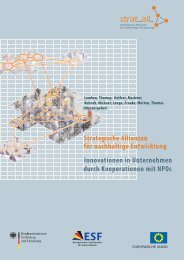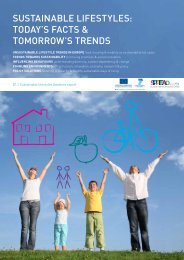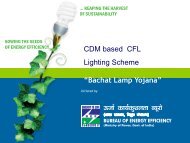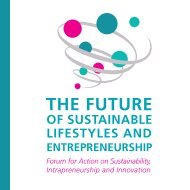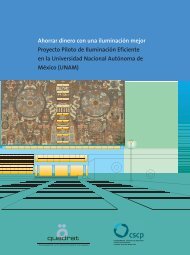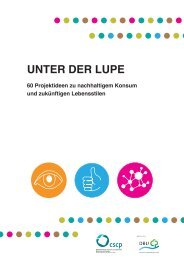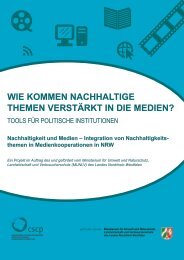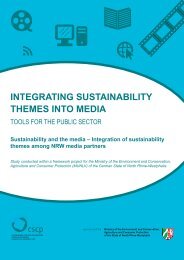sustainable buildings and construction in africa - Collaborating ...
sustainable buildings and construction in africa - Collaborating ...
sustainable buildings and construction in africa - Collaborating ...
Create successful ePaper yourself
Turn your PDF publications into a flip-book with our unique Google optimized e-Paper software.
SUSTAINABLE BUILDINGS<br />
AND CONSTRUCTION<br />
IN AFRICA<br />
OVERVIEW OF SBC IN I AFRICA<br />
PRACTICAL INSII<br />
IGHTS AND ILLUSTRATII<br />
IVE EXAMPLES<br />
ORGANISATIONS WORKING ON SBC IN I AFRICA<br />
<br />
LITERATURE AND ONLINE RESOURCES ON SBC IN I AFRICA
SUSTAINABLE BUILDINGS<br />
AND CONSTRUCTION<br />
IN AFRICA<br />
OVERVIEW OF SBC IN I AFRICA<br />
PRACTICAL INSII<br />
IGHTS AND ILLUSTRATII<br />
IVE EXAMPLES<br />
ORGANISATIONS WORKING ON SBC IN I AFRICA<br />
<br />
LITERATURE AND ONLINE RESOURCES ON SBC IN I AFRICA
FOREWORD BY THE MARRAKECH TASK FORCE ON COOPERATION WITH AFRICA, LEAD COUNTRY GERMANY<br />
<br />
The Marrakech Task Forces are part of the Marrakech Process on Susta<strong>in</strong>able Consumption <strong>and</strong> Production (SCP), which also <strong>in</strong>cludes regional<br />
structures, a secretariat at UN-DESA <strong>and</strong> UNEP, an advisory committee <strong>in</strong>volv<strong>in</strong>g regions <strong>and</strong> the most relevant stakeholders as well as numerous<br />
activities around the globe. A Marrakech Task Force is an <strong>in</strong>formal group of countries <strong>and</strong> organisations coord<strong>in</strong>ated by a lead country that have<br />
decided to work collaboratively on a specific issue of SCP committed to carry out a set of activities which support the implementation of projects of<br />
the Marrakech Process.<br />
The Marrakech Task Force on “Cooperation with Africa” aims generally at support<strong>in</strong>g African activities on SCP. It will promote the implementation<br />
of measures on SCP <strong>in</strong> Africa, encourage <strong>and</strong> support African countries <strong>in</strong> the <strong>in</strong>tegration of SCP <strong>in</strong> exist<strong>in</strong>g programmes as well as <strong>in</strong>itiate new<br />
ones. One priority area is the development of national <strong>and</strong>/or regional action plans on SCP that allow them to leapfrog, reduce poverty while<br />
adopt<strong>in</strong>g <strong>susta<strong>in</strong>able</strong> consumption <strong>and</strong> production patterns. A second priority area is the development <strong>and</strong> the implementation of an African<br />
Ecolabell<strong>in</strong>g Mechanism (AEM) which shall work <strong>in</strong> all African countries.<br />
A third priority area is the implementation of results <strong>and</strong> f<strong>in</strong>d<strong>in</strong>gs of other task forces <strong>in</strong> African countries. In that regard we are very thankful <strong>in</strong><br />
particular to the Swiss Task Force on “Susta<strong>in</strong>able Procurement”, the Swedish Task Force on “Susta<strong>in</strong>able Lifestyles” <strong>and</strong> the F<strong>in</strong>nish Task Force<br />
on “Susta<strong>in</strong>able Build<strong>in</strong>g <strong>and</strong> Construction” for their work <strong>in</strong> Africa <strong>and</strong> the cooperation.<br />
This Brief Book is the result of the cooperation between the F<strong>in</strong>nish <strong>and</strong> the German task force. It gives an overview of activities <strong>in</strong> the field of<br />
<strong>susta<strong>in</strong>able</strong> build<strong>in</strong>g <strong>and</strong> <strong>construction</strong> <strong>in</strong> Africa as well as it lists concrete sources for <strong>in</strong>formation on how to do <strong>susta<strong>in</strong>able</strong> <strong>construction</strong> <strong>and</strong><br />
build<strong>in</strong>g <strong>in</strong> Africa. The aim is to promote <strong>susta<strong>in</strong>able</strong> <strong>construction</strong> <strong>and</strong> build<strong>in</strong>g <strong>in</strong> Africa <strong>and</strong> give guidance where needed.<br />
Dr. Ulf Jaeckel, Chair of the Marrakech Task Force on “Cooperation with Africa”
FOREWORD BY THE MARRAKECH TASK FORCE ON SUSTAINABLE BUILDINGS AND CONSTRUCTION, LEAD COUNTRY FINLAND<br />
Our built environment has profound impacts on people, planet <strong>and</strong> prosperity. It consumes natural resources, creates employment <strong>and</strong> property<br />
values, <strong>and</strong> provides shelter for our daily life. Worldwide, we face the same capacity build<strong>in</strong>g challenge to ma<strong>in</strong>stream susta<strong>in</strong>ability as a key<br />
pr<strong>in</strong>ciple <strong>in</strong> <strong>construction</strong> <strong>and</strong> real estate sectors. This publication does not claim to cover all aspects or examples. For example, despite of its<br />
central importance, the role of the public sector is not discussed. This is meant as an <strong>in</strong>put <strong>in</strong>to an ongo<strong>in</strong>g discussion about <strong>susta<strong>in</strong>able</strong><br />
communities.<br />
A particular characteristic of <strong>build<strong>in</strong>gs</strong> is that their life cycle is long – anyth<strong>in</strong>g from twenty to thous<strong>and</strong>s of years. This fact has many implications.<br />
At different stages of the process of produc<strong>in</strong>g <strong>and</strong> us<strong>in</strong>g a build<strong>in</strong>g a great number of stakeholders is <strong>in</strong>volved. L<strong>and</strong> owners, <strong>in</strong>vestors, designers,<br />
builders, tenants, users, facility managers or janitors, to name just a few, may never meet each other, <strong>and</strong> may not have any <strong>in</strong>terests <strong>in</strong> common.<br />
Another implication is that every decision to build or refurbish a build<strong>in</strong>g has a long-term effect. As an example, if a house is constructed or<br />
renovated poorly now, its poor energy performance will be “locked <strong>in</strong>” for decades before the next renovation cycle.<br />
Construction <strong>and</strong> ma<strong>in</strong>tenance of <strong>build<strong>in</strong>gs</strong> requires low-technology, it is no rocket science. A lot can be learned from the traditional craft of<br />
build<strong>in</strong>g: use of local materials, methods of natural ventilation <strong>and</strong> creat<strong>in</strong>g shade, or protect<strong>in</strong>g from ra<strong>in</strong> <strong>and</strong> humidity. We have no illusions about<br />
“traditional architecture”, but technology is not the key solution. Susta<strong>in</strong>able <strong>build<strong>in</strong>gs</strong> are user friendly, easy-to-ma<strong>in</strong>ta<strong>in</strong>. They are economical,<br />
because they do not waste resources, neither when they are constructed, nor when used.<br />
Let me thank the German Task Force for its leadership <strong>in</strong> cooperation with Africa, <strong>and</strong> for its generous <strong>in</strong>vitation to co-author this publication. By<br />
tak<strong>in</strong>g the lead of the SBC Task Force <strong>in</strong> 2006, F<strong>in</strong>l<strong>and</strong> acknowledged the importance of <strong>build<strong>in</strong>gs</strong> as well as the great susta<strong>in</strong>ability challenges<br />
<strong>and</strong> opportunities <strong>in</strong> the <strong>construction</strong> <strong>and</strong> real estate sector. We all share the same questions, but the solutions must emerge from the local<br />
cultural, societal <strong>and</strong> climatic context.<br />
Dr. Kaar<strong>in</strong> Taipale, Chair of the Marrakech Task Force on Susta<strong>in</strong>able Build<strong>in</strong>gs <strong>and</strong> Construction
FOREWORD BY THE MARRAKECH TASK FORCE ON SUSTAINABLE BUILDINGS AND CONSTRUCTION, LEAD COUNTRY FINLAND<br />
Our built environment has profound impacts on people, planet <strong>and</strong> prosperity. It consumes natural resources, creates employment <strong>and</strong> property<br />
values, <strong>and</strong> provides shelter for our daily life. Worldwide, we face the same capacity build<strong>in</strong>g challenge to ma<strong>in</strong>stream susta<strong>in</strong>ability as a key<br />
pr<strong>in</strong>ciple <strong>in</strong> <strong>construction</strong> <strong>and</strong> real estate sectors. This publication does not claim to cover all aspects or examples. For example, despite of its<br />
central importance, the role of the public sector is not discussed. This is meant as an <strong>in</strong>put <strong>in</strong>to an ongo<strong>in</strong>g discussion about <strong>susta<strong>in</strong>able</strong><br />
communities.<br />
A particular characteristic of <strong>build<strong>in</strong>gs</strong> is that their life cycle is long – anyth<strong>in</strong>g from twenty to thous<strong>and</strong>s of years. This fact has many implications.<br />
At different stages of the process of produc<strong>in</strong>g <strong>and</strong> us<strong>in</strong>g a build<strong>in</strong>g a great number of stakeholders is <strong>in</strong>volved. L<strong>and</strong> owners, <strong>in</strong>vestors, designers,<br />
builders, tenants, users, facility managers or janitors, to name just a few, may never meet each other, <strong>and</strong> may not have any <strong>in</strong>terests <strong>in</strong> common.<br />
Another implication is that every decision to build or refurbish a build<strong>in</strong>g has a long-term effect. As an example, if a house is constructed or<br />
renovated poorly now, its poor energy performance will be “locked <strong>in</strong>” for decades before the next renovation cycle.<br />
Construction <strong>and</strong> ma<strong>in</strong>tenance of <strong>build<strong>in</strong>gs</strong> requires low-technology, it is no rocket science. A lot can be learned from the traditional craft of<br />
build<strong>in</strong>g: use of local materials, methods of natural ventilation <strong>and</strong> creat<strong>in</strong>g shade, or protect<strong>in</strong>g from ra<strong>in</strong> <strong>and</strong> humidity. We have no illusions about<br />
“traditional architecture”, but technology is not the key solution. Susta<strong>in</strong>able <strong>build<strong>in</strong>gs</strong> are user friendly, easy-to-ma<strong>in</strong>ta<strong>in</strong>. They are economical,<br />
because they do not waste resources, neither when they are constructed, nor when used.<br />
Let me thank the German Task Force for its leadership <strong>in</strong> cooperation with Africa, <strong>and</strong> for its generous <strong>in</strong>vitation to co-author this publication. By<br />
tak<strong>in</strong>g the lead of the SBC Task Force <strong>in</strong> 2006, F<strong>in</strong>l<strong>and</strong> acknowledged the importance of <strong>build<strong>in</strong>gs</strong> as well as the great susta<strong>in</strong>ability challenges<br />
<strong>and</strong> opportunities <strong>in</strong> the <strong>construction</strong> <strong>and</strong> real estate sector. We all share the same questions, but the solutions must emerge from the local<br />
cultural, societal <strong>and</strong> climatic context.<br />
Dr. Kaar<strong>in</strong> Taipale, Chair of the Marrakech Task Force on Susta<strong>in</strong>able Build<strong>in</strong>gs <strong>and</strong> Construction
FOREWORD BY THE MARRAKECH TASK FORCE ON SUSTAINABLE BUILDINGS AND CONSTRUCTION, LEAD COUNTRY FINLAND<br />
Our built environment has profound impacts on people, planet <strong>and</strong> prosperity. It consumes natural resources, creates employment <strong>and</strong> property<br />
values, <strong>and</strong> provides shelter for our daily life. Worldwide, we face the same capacity build<strong>in</strong>g challenge to ma<strong>in</strong>stream susta<strong>in</strong>ability as a key<br />
pr<strong>in</strong>ciple <strong>in</strong> <strong>construction</strong> <strong>and</strong> real estate sectors. This publication does not claim to cover all aspects or examples. For example, despite of its<br />
central importance, the role of the public sector is not discussed. This is meant as an <strong>in</strong>put <strong>in</strong>to an ongo<strong>in</strong>g discussion about <strong>susta<strong>in</strong>able</strong><br />
communities.<br />
A particular characteristic of <strong>build<strong>in</strong>gs</strong> is that their life cycle is long – anyth<strong>in</strong>g from twenty to thous<strong>and</strong>s of years. This fact has many implications.<br />
At different stages of the process of produc<strong>in</strong>g <strong>and</strong> us<strong>in</strong>g a build<strong>in</strong>g a great number of stakeholders is <strong>in</strong>volved. L<strong>and</strong> owners, <strong>in</strong>vestors, designers,<br />
builders, tenants, users, facility managers or janitors, to name just a few, may never meet each other, <strong>and</strong> may not have any <strong>in</strong>terests <strong>in</strong> common.<br />
Another implication is that every decision to build or refurbish a build<strong>in</strong>g has a long-term effect. As an example, if a house is constructed or<br />
renovated poorly now, its poor energy performance will be “locked <strong>in</strong>” for decades before the next renovation cycle.<br />
Construction <strong>and</strong> ma<strong>in</strong>tenance of <strong>build<strong>in</strong>gs</strong> requires low-technology, it is no rocket science. A lot can be learned from the traditional craft of<br />
build<strong>in</strong>g: use of local materials, methods of natural ventilation <strong>and</strong> creat<strong>in</strong>g shade, or protect<strong>in</strong>g from ra<strong>in</strong> <strong>and</strong> humidity. We have no illusions about<br />
“traditional architecture”, but technology is not the key solution. Susta<strong>in</strong>able <strong>build<strong>in</strong>gs</strong> are user friendly, easy-to-ma<strong>in</strong>ta<strong>in</strong>. They are economical,<br />
because they do not waste resources, neither when they are constructed, nor when used.<br />
Let me thank the German Task Force for its leadership <strong>in</strong> cooperation with Africa, <strong>and</strong> for its generous <strong>in</strong>vitation to co-author this publication. By<br />
tak<strong>in</strong>g the lead of the SBC Task Force <strong>in</strong> 2006, F<strong>in</strong>l<strong>and</strong> acknowledged the importance of <strong>build<strong>in</strong>gs</strong> as well as the great susta<strong>in</strong>ability challenges<br />
<strong>and</strong> opportunities <strong>in</strong> the <strong>construction</strong> <strong>and</strong> real estate sector. We all share the same questions, but the solutions must emerge from the local<br />
cultural, societal <strong>and</strong> climatic context.<br />
Dr. Kaar<strong>in</strong> Taipale, Chair of the Marrakech Task Force on Susta<strong>in</strong>able Build<strong>in</strong>gs <strong>and</strong> Construction
FOREWORD BY THE MARRAKECH TASK FORCE ON SUSTAINABLE BUILDINGS AND CONSTRUCTION, LEAD COUNTRY FINLAND<br />
Our built environment has profound impacts on people, planet <strong>and</strong> prosperity. It consumes natural resources, creates employment <strong>and</strong> property<br />
values, <strong>and</strong> provides shelter for our daily life. Worldwide, we face the same capacity build<strong>in</strong>g challenge to ma<strong>in</strong>stream susta<strong>in</strong>ability as a key<br />
pr<strong>in</strong>ciple <strong>in</strong> <strong>construction</strong> <strong>and</strong> real estate sectors. This publication does not claim to cover all aspects or examples. For example, despite of its<br />
central importance, the role of the public sector is not discussed. This is meant as an <strong>in</strong>put <strong>in</strong>to an ongo<strong>in</strong>g discussion about <strong>susta<strong>in</strong>able</strong><br />
communities.<br />
A particular characteristic of <strong>build<strong>in</strong>gs</strong> is that their life cycle is long – anyth<strong>in</strong>g from twenty to thous<strong>and</strong>s of years. This fact has many implications.<br />
At different stages of the process of produc<strong>in</strong>g <strong>and</strong> us<strong>in</strong>g a build<strong>in</strong>g a great number of stakeholders is <strong>in</strong>volved. L<strong>and</strong> owners, <strong>in</strong>vestors, designers,<br />
builders, tenants, users, facility managers or janitors, to name just a few, may never meet each other, <strong>and</strong> may not have any <strong>in</strong>terests <strong>in</strong> common.<br />
Another implication is that every decision to build or refurbish a build<strong>in</strong>g has a long-term effect. As an example, if a house is constructed or<br />
renovated poorly now, its poor energy performance will be “locked <strong>in</strong>” for decades before the next renovation cycle.<br />
Construction <strong>and</strong> ma<strong>in</strong>tenance of <strong>build<strong>in</strong>gs</strong> requires low-technology, it is no rocket science. A lot can be learned from the traditional craft of<br />
build<strong>in</strong>g: use of local materials, methods of natural ventilation <strong>and</strong> creat<strong>in</strong>g shade, or protect<strong>in</strong>g from ra<strong>in</strong> <strong>and</strong> humidity. We have no illusions about<br />
“traditional architecture”, but technology is not the key solution. Susta<strong>in</strong>able <strong>build<strong>in</strong>gs</strong> are user friendly, easy-to-ma<strong>in</strong>ta<strong>in</strong>. They are economical,<br />
because they do not waste resources, neither when they are constructed, nor when used.<br />
Let me thank the German Task Force for its leadership <strong>in</strong> cooperation with Africa, <strong>and</strong> for its generous <strong>in</strong>vitation to co-author this publication. By<br />
tak<strong>in</strong>g the lead of the SBC Task Force <strong>in</strong> 2006, F<strong>in</strong>l<strong>and</strong> acknowledged the importance of <strong>build<strong>in</strong>gs</strong> as well as the great susta<strong>in</strong>ability challenges<br />
<strong>and</strong> opportunities <strong>in</strong> the <strong>construction</strong> <strong>and</strong> real estate sector. We all share the same questions, but the solutions must emerge from the local<br />
cultural, societal <strong>and</strong> climatic context.<br />
Dr. Kaar<strong>in</strong> Taipale, Chair of the Marrakech Task Force on Susta<strong>in</strong>able Build<strong>in</strong>gs <strong>and</strong> Construction
FOREWORD BY THE MARRAKECH TASK FORCE ON SUSTAINABLE BUILDINGS AND CONSTRUCTION, LEAD COUNTRY FINLAND<br />
Our built environment has profound impacts on people, planet <strong>and</strong> prosperity. It consumes natural resources, creates employment <strong>and</strong> property<br />
values, <strong>and</strong> provides shelter for our daily life. Worldwide, we face the same capacity build<strong>in</strong>g challenge to ma<strong>in</strong>stream susta<strong>in</strong>ability as a key<br />
pr<strong>in</strong>ciple <strong>in</strong> <strong>construction</strong> <strong>and</strong> real estate sectors. This publication does not claim to cover all aspects or examples. For example, despite of its<br />
central importance, the role of the public sector is not discussed. This is meant as an <strong>in</strong>put <strong>in</strong>to an ongo<strong>in</strong>g discussion about <strong>susta<strong>in</strong>able</strong><br />
communities.<br />
A particular characteristic of <strong>build<strong>in</strong>gs</strong> is that their life cycle is long – anyth<strong>in</strong>g from twenty to thous<strong>and</strong>s of years. This fact has many implications.<br />
At different stages of the process of produc<strong>in</strong>g <strong>and</strong> us<strong>in</strong>g a build<strong>in</strong>g a great number of stakeholders is <strong>in</strong>volved. L<strong>and</strong> owners, <strong>in</strong>vestors, designers,<br />
builders, tenants, users, facility managers or janitors, to name just a few, may never meet each other, <strong>and</strong> may not have any <strong>in</strong>terests <strong>in</strong> common.<br />
Another implication is that every decision to build or refurbish a build<strong>in</strong>g has a long-term effect. As an example, if a house is constructed or<br />
renovated poorly now, its poor energy performance will be “locked <strong>in</strong>” for decades before the next renovation cycle.<br />
Construction <strong>and</strong> ma<strong>in</strong>tenance of <strong>build<strong>in</strong>gs</strong> requires low-technology, it is no rocket science. A lot can be learned from the traditional craft of<br />
build<strong>in</strong>g: use of local materials, methods of natural ventilation <strong>and</strong> creat<strong>in</strong>g shade, or protect<strong>in</strong>g from ra<strong>in</strong> <strong>and</strong> humidity. We have no illusions about<br />
“traditional architecture”, but technology is not the key solution. Susta<strong>in</strong>able <strong>build<strong>in</strong>gs</strong> are user friendly, easy-to-ma<strong>in</strong>ta<strong>in</strong>. They are economical,<br />
because they do not waste resources, neither when they are constructed, nor when used.<br />
Let me thank the German Task Force for its leadership <strong>in</strong> cooperation with Africa, <strong>and</strong> for its generous <strong>in</strong>vitation to co-author this publication. By<br />
tak<strong>in</strong>g the lead of the SBC Task Force <strong>in</strong> 2006, F<strong>in</strong>l<strong>and</strong> acknowledged the importance of <strong>build<strong>in</strong>gs</strong> as well as the great susta<strong>in</strong>ability challenges<br />
<strong>and</strong> opportunities <strong>in</strong> the <strong>construction</strong> <strong>and</strong> real estate sector. We all share the same questions, but the solutions must emerge from the local<br />
cultural, societal <strong>and</strong> climatic context.<br />
Dr. Kaar<strong>in</strong> Taipale, Chair of the Marrakech Task Force on Susta<strong>in</strong>able Build<strong>in</strong>gs <strong>and</strong> Construction
FOREWORD BY THE MARRAKECH TASK FORCE ON SUSTAINABLE BUILDINGS AND CONSTRUCTION, LEAD COUNTRY FINLAND<br />
Our built environment has profound impacts on people, planet <strong>and</strong> prosperity. It consumes natural resources, creates employment <strong>and</strong> property<br />
values, <strong>and</strong> provides shelter for our daily life. Worldwide, we face the same capacity build<strong>in</strong>g challenge to ma<strong>in</strong>stream susta<strong>in</strong>ability as a key<br />
pr<strong>in</strong>ciple <strong>in</strong> <strong>construction</strong> <strong>and</strong> real estate sectors. This publication does not claim to cover all aspects or examples. For example, despite of its<br />
central importance, the role of the public sector is not discussed. This is meant as an <strong>in</strong>put <strong>in</strong>to an ongo<strong>in</strong>g discussion about <strong>susta<strong>in</strong>able</strong><br />
communities.<br />
A particular characteristic of <strong>build<strong>in</strong>gs</strong> is that their life cycle is long – anyth<strong>in</strong>g from twenty to thous<strong>and</strong>s of years. This fact has many implications.<br />
At different stages of the process of produc<strong>in</strong>g <strong>and</strong> us<strong>in</strong>g a build<strong>in</strong>g a great number of stakeholders is <strong>in</strong>volved. L<strong>and</strong> owners, <strong>in</strong>vestors, designers,<br />
builders, tenants, users, facility managers or janitors, to name just a few, may never meet each other, <strong>and</strong> may not have any <strong>in</strong>terests <strong>in</strong> common.<br />
Another implication is that every decision to build or refurbish a build<strong>in</strong>g has a long-term effect. As an example, if a house is constructed or<br />
renovated poorly now, its poor energy performance will be “locked <strong>in</strong>” for decades before the next renovation cycle.<br />
Construction <strong>and</strong> ma<strong>in</strong>tenance of <strong>build<strong>in</strong>gs</strong> requires low-technology, it is no rocket science. A lot can be learned from the traditional craft of<br />
build<strong>in</strong>g: use of local materials, methods of natural ventilation <strong>and</strong> creat<strong>in</strong>g shade, or protect<strong>in</strong>g from ra<strong>in</strong> <strong>and</strong> humidity. We have no illusions about<br />
“traditional architecture”, but technology is not the key solution. Susta<strong>in</strong>able <strong>build<strong>in</strong>gs</strong> are user friendly, easy-to-ma<strong>in</strong>ta<strong>in</strong>. They are economical,<br />
because they do not waste resources, neither when they are constructed, nor when used.<br />
Let me thank the German Task Force for its leadership <strong>in</strong> cooperation with Africa, <strong>and</strong> for its generous <strong>in</strong>vitation to co-author this publication. By<br />
tak<strong>in</strong>g the lead of the SBC Task Force <strong>in</strong> 2006, F<strong>in</strong>l<strong>and</strong> acknowledged the importance of <strong>build<strong>in</strong>gs</strong> as well as the great susta<strong>in</strong>ability challenges<br />
<strong>and</strong> opportunities <strong>in</strong> the <strong>construction</strong> <strong>and</strong> real estate sector. We all share the same questions, but the solutions must emerge from the local<br />
cultural, societal <strong>and</strong> climatic context.<br />
Dr. Kaar<strong>in</strong> Taipale, Chair of the Marrakech Task Force on Susta<strong>in</strong>able Build<strong>in</strong>gs <strong>and</strong> Construction
FOREWORD BY THE MARRAKECH TASK FORCE ON SUSTAINABLE BUILDINGS AND CONSTRUCTION, LEAD COUNTRY FINLAND<br />
Our built environment has profound impacts on people, planet <strong>and</strong> prosperity. It consumes natural resources, creates employment <strong>and</strong> property<br />
values, <strong>and</strong> provides shelter for our daily life. Worldwide, we face the same capacity build<strong>in</strong>g challenge to ma<strong>in</strong>stream susta<strong>in</strong>ability as a key<br />
pr<strong>in</strong>ciple <strong>in</strong> <strong>construction</strong> <strong>and</strong> real estate sectors. This publication does not claim to cover all aspects or examples. For example, despite of its<br />
central importance, the role of the public sector is not discussed. This is meant as an <strong>in</strong>put <strong>in</strong>to an ongo<strong>in</strong>g discussion about <strong>susta<strong>in</strong>able</strong><br />
communities.<br />
A particular characteristic of <strong>build<strong>in</strong>gs</strong> is that their life cycle is long – anyth<strong>in</strong>g from twenty to thous<strong>and</strong>s of years. This fact has many implications.<br />
At different stages of the process of produc<strong>in</strong>g <strong>and</strong> us<strong>in</strong>g a build<strong>in</strong>g a great number of stakeholders is <strong>in</strong>volved. L<strong>and</strong> owners, <strong>in</strong>vestors, designers,<br />
builders, tenants, users, facility managers or janitors, to name just a few, may never meet each other, <strong>and</strong> may not have any <strong>in</strong>terests <strong>in</strong> common.<br />
Another implication is that every decision to build or refurbish a build<strong>in</strong>g has a long-term effect. As an example, if a house is constructed or<br />
renovated poorly now, its poor energy performance will be “locked <strong>in</strong>” for decades before the next renovation cycle.<br />
Construction <strong>and</strong> ma<strong>in</strong>tenance of <strong>build<strong>in</strong>gs</strong> requires low-technology, it is no rocket science. A lot can be learned from the traditional craft of<br />
build<strong>in</strong>g: use of local materials, methods of natural ventilation <strong>and</strong> creat<strong>in</strong>g shade, or protect<strong>in</strong>g from ra<strong>in</strong> <strong>and</strong> humidity. We have no illusions about<br />
“traditional architecture”, but technology is not the key solution. Susta<strong>in</strong>able <strong>build<strong>in</strong>gs</strong> are user friendly, easy-to-ma<strong>in</strong>ta<strong>in</strong>. They are economical,<br />
because they do not waste resources, neither when they are constructed, nor when used.<br />
Let me thank the German Task Force for its leadership <strong>in</strong> cooperation with Africa, <strong>and</strong> for its generous <strong>in</strong>vitation to co-author this publication. By<br />
tak<strong>in</strong>g the lead of the SBC Task Force <strong>in</strong> 2006, F<strong>in</strong>l<strong>and</strong> acknowledged the importance of <strong>build<strong>in</strong>gs</strong> as well as the great susta<strong>in</strong>ability challenges<br />
<strong>and</strong> opportunities <strong>in</strong> the <strong>construction</strong> <strong>and</strong> real estate sector. We all share the same questions, but the solutions must emerge from the local<br />
cultural, societal <strong>and</strong> climatic context.<br />
Dr. Kaar<strong>in</strong> Taipale, Chair of the Marrakech Task Force on Susta<strong>in</strong>able Build<strong>in</strong>gs <strong>and</strong> Construction
3 rd public draft of the 10YFP, UNDESA <strong>and</strong> UNEP, Sept. 2009
Refurbishment,<br />
Reuse<br />
Demolition,<br />
Recycle<br />
Operation <strong>and</strong><br />
ma<strong>in</strong>tenance<br />
<br />
Brief<strong>in</strong>g<br />
H<strong>and</strong> over<br />
Site analysis<br />
Target sett<strong>in</strong>g<br />
Design<br />
development<br />
Detailed<br />
design<br />
Production of <strong>construction</strong><br />
materials<br />
Construction
Refurbishment,<br />
Reuse<br />
Demolition,<br />
Recycle<br />
Operation <strong>and</strong><br />
ma<strong>in</strong>tenance<br />
<br />
Brief<strong>in</strong>g<br />
H<strong>and</strong> over<br />
Site analysis<br />
Target sett<strong>in</strong>g<br />
Design<br />
development<br />
Detailed<br />
design<br />
Production of <strong>construction</strong><br />
materials<br />
Construction
Refurbishment,<br />
Reuse<br />
Demolition,<br />
Recycle<br />
Operation <strong>and</strong><br />
ma<strong>in</strong>tenance<br />
<br />
Brief<strong>in</strong>g<br />
H<strong>and</strong> over<br />
Site analysis<br />
Target sett<strong>in</strong>g<br />
Design<br />
development<br />
Detailed<br />
design<br />
Production of <strong>construction</strong><br />
materials<br />
Construction
Well-be<strong>in</strong>g<br />
Individual scale<br />
Health<br />
Neighbor<strong>in</strong>g <strong>build<strong>in</strong>gs</strong><br />
Local water<br />
reserves<br />
Resource<br />
Depletion<br />
<br />
Local<br />
economy<br />
Local scale<br />
Emission of<br />
Greenhouse Gases<br />
Regional/<br />
Global scale
Social<br />
Environmental<br />
Local<br />
Economy<br />
Efficiency<br />
of Use<br />
Capital<br />
Investment<br />
Ongo<strong>in</strong>g<br />
operational<br />
Costs<br />
Adaptability<br />
& Flexibility<br />
Economic<br />
Public<br />
participatio<br />
Occupant<br />
Comfort<br />
Access to<br />
basic<br />
services<br />
Inclusive<br />
Environments<br />
Health &<br />
Safety<br />
Energy<br />
Waste<br />
L<strong>and</strong><br />
Natural<br />
resource<br />
consumption<br />
Water
Social<br />
Environmental<br />
Local<br />
Economy<br />
Efficiency<br />
of Use<br />
Capital<br />
Investment<br />
Ongo<strong>in</strong>g<br />
operational<br />
Costs<br />
Adaptability<br />
& Flexibility<br />
Economic<br />
Public<br />
participatio<br />
Occupant<br />
Comfort<br />
Access to<br />
basic<br />
services<br />
Inclusive<br />
Environments<br />
Health &<br />
Safety<br />
Energy<br />
Waste<br />
L<strong>and</strong><br />
Natural<br />
resource<br />
consumption<br />
Water
Social<br />
Environmental<br />
Local<br />
Economy<br />
Efficiency<br />
of Use<br />
Capital<br />
Investment<br />
Ongo<strong>in</strong>g<br />
operational<br />
Costs<br />
Adaptability<br />
& Flexibility<br />
Economic<br />
Public<br />
participatio<br />
Occupant<br />
Comfort<br />
Access to<br />
basic<br />
services<br />
Inclusive<br />
Environments<br />
Health &<br />
Safety<br />
Energy<br />
Waste<br />
L<strong>and</strong><br />
Natural<br />
resource<br />
consumption<br />
Water
Social<br />
Environmental<br />
Local<br />
Economy<br />
Efficiency<br />
of Use<br />
Capital<br />
Investment<br />
Ongo<strong>in</strong>g<br />
operational<br />
Costs<br />
Adaptability<br />
& Flexibility<br />
Economic<br />
Public<br />
participatio<br />
Occupant<br />
Comfort<br />
Access to<br />
basic<br />
services<br />
Inclusive<br />
Environments<br />
Health &<br />
Safety<br />
Energy<br />
Waste<br />
L<strong>and</strong><br />
Natural<br />
resource<br />
consumption<br />
Water
Social<br />
Environmental<br />
Local<br />
Economy<br />
Efficiency<br />
of Use<br />
Capital<br />
Investment<br />
Ongo<strong>in</strong>g<br />
operational<br />
Costs<br />
Adaptability<br />
& Flexibility<br />
Economic<br />
Public<br />
participatio<br />
Occupant<br />
Comfort<br />
Access to<br />
basic<br />
services<br />
Inclusive<br />
Environments<br />
Health &<br />
Safety<br />
Energy<br />
Waste<br />
L<strong>and</strong><br />
Natural<br />
resource<br />
consumption<br />
Water
Social<br />
Environmental<br />
Local<br />
Economy<br />
Efficiency<br />
of Use<br />
Capital<br />
Investment<br />
Ongo<strong>in</strong>g<br />
operational<br />
Costs<br />
Adaptability<br />
& Flexibility<br />
Economic<br />
Public<br />
participatio<br />
Occupant<br />
Comfort<br />
Access to<br />
basic<br />
services<br />
Inclusive<br />
Environments<br />
Health &<br />
Safety<br />
Energy<br />
Waste<br />
L<strong>and</strong><br />
Natural<br />
resource<br />
consumption<br />
Water
Social<br />
Environmental<br />
Local<br />
Economy<br />
Efficiency<br />
of Use<br />
Capital<br />
Investment<br />
Ongo<strong>in</strong>g<br />
operational<br />
Costs<br />
Adaptability<br />
& Flexibility<br />
Economic<br />
Public<br />
participatio<br />
Occupant<br />
Comfort<br />
Access to<br />
basic<br />
services<br />
Inclusive<br />
Environments<br />
Health &<br />
Safety<br />
Energy<br />
Waste<br />
L<strong>and</strong><br />
Natural<br />
resource<br />
consumption<br />
Water
Social<br />
Environmental<br />
Local<br />
Economy<br />
Efficiency<br />
of Use<br />
Capital<br />
Investment<br />
Ongo<strong>in</strong>g<br />
operational<br />
Costs<br />
Adaptability<br />
& Flexibility<br />
Economic<br />
Public<br />
participatio<br />
Occupant<br />
Comfort<br />
Access to<br />
basic<br />
services<br />
Inclusive<br />
Environments<br />
Health &<br />
Safety<br />
Energy<br />
Waste<br />
L<strong>and</strong><br />
Natural<br />
resource<br />
consumption<br />
Water
Social<br />
Environmental<br />
Local<br />
Economy<br />
Efficiency<br />
of Use<br />
Capital<br />
Investment<br />
Ongo<strong>in</strong>g<br />
operational<br />
Costs<br />
Adaptability<br />
& Flexibility<br />
Economic<br />
Public<br />
participatio<br />
Occupant<br />
Comfort<br />
Access to<br />
basic<br />
services<br />
Inclusive<br />
Environments<br />
Health &<br />
Safety<br />
Energy<br />
Waste<br />
L<strong>and</strong><br />
Natural<br />
resource<br />
consumption<br />
Water
Social<br />
Environmental<br />
Local<br />
Economy<br />
Efficiency<br />
of Use<br />
Capital<br />
Investment<br />
Ongo<strong>in</strong>g<br />
operational<br />
Costs<br />
Adaptability<br />
& Flexibility<br />
Economic<br />
Public<br />
participatio<br />
Occupant<br />
Comfort<br />
Access to<br />
basic<br />
services<br />
Inclusive<br />
Environments<br />
Health &<br />
Safety<br />
Energy<br />
Waste<br />
L<strong>and</strong><br />
Natural<br />
resource<br />
consumption<br />
Water
Social<br />
Environmental<br />
Local<br />
Economy<br />
Efficiency<br />
of Use<br />
Capital<br />
Investment<br />
Ongo<strong>in</strong>g<br />
operational<br />
Costs<br />
Adaptability<br />
& Flexibility<br />
Economic<br />
Public<br />
participatio<br />
Occupant<br />
Comfort<br />
Access to<br />
basic<br />
services<br />
Inclusive<br />
Environments<br />
Health &<br />
Safety<br />
Energy<br />
Waste<br />
L<strong>and</strong><br />
Natural<br />
resource<br />
consumption<br />
Water
Social<br />
Environmental<br />
Local<br />
Economy<br />
Efficiency<br />
of Use<br />
Capital<br />
Investment<br />
Ongo<strong>in</strong>g<br />
operational<br />
Costs<br />
Adaptability<br />
& Flexibility<br />
Economic<br />
Public<br />
participatio<br />
Occupant<br />
Comfort<br />
Access to<br />
basic<br />
services<br />
Inclusive<br />
Environments<br />
Health &<br />
Safety<br />
Energy<br />
Waste<br />
L<strong>and</strong><br />
Natural<br />
resource<br />
consumption<br />
Water
Social<br />
Environmental<br />
Local<br />
Economy<br />
Efficiency<br />
of Use<br />
Capital<br />
Investment<br />
Ongo<strong>in</strong>g<br />
operational<br />
Costs<br />
Adaptability<br />
& Flexibility<br />
Economic<br />
Public<br />
participatio<br />
Occupant<br />
Comfort<br />
Access to<br />
basic<br />
services<br />
Inclusive<br />
Environments<br />
Health &<br />
Safety<br />
Energy<br />
Waste<br />
L<strong>and</strong><br />
Natural<br />
resource<br />
consumption<br />
Water
Social<br />
Environmental<br />
Local<br />
Economy<br />
Efficiency<br />
of Use<br />
Capital<br />
Investment<br />
Ongo<strong>in</strong>g<br />
operational<br />
Costs<br />
Adaptability<br />
& Flexibility<br />
Economic<br />
Public<br />
participatio<br />
Occupant<br />
Comfort<br />
Access to<br />
basic<br />
services<br />
Inclusive<br />
Environments<br />
Health &<br />
Safety<br />
Energy<br />
Waste<br />
L<strong>and</strong><br />
Natural<br />
resource<br />
consumption<br />
Water
Social<br />
Environmental<br />
Local<br />
Economy<br />
Efficiency<br />
of Use<br />
Capital<br />
Investment<br />
Ongo<strong>in</strong>g<br />
operational<br />
Costs<br />
Adaptability<br />
& Flexibility<br />
Economic<br />
Public<br />
participatio<br />
Occupant<br />
Comfort<br />
Access to<br />
basic<br />
services<br />
Inclusive<br />
Environments<br />
Health &<br />
Safety<br />
Energy<br />
Waste<br />
L<strong>and</strong><br />
Natural<br />
resource<br />
consumption<br />
Water
Social<br />
Environmental<br />
Local<br />
Economy<br />
Efficiency<br />
of Use<br />
Capital<br />
Investment<br />
Ongo<strong>in</strong>g<br />
operational<br />
Costs<br />
Adaptability<br />
& Flexibility<br />
Economic<br />
Public<br />
participatio<br />
Occupant<br />
Comfort<br />
Access to<br />
basic<br />
services<br />
Inclusive<br />
Environments<br />
Health &<br />
Safety<br />
Energy<br />
Waste<br />
L<strong>and</strong><br />
Natural<br />
resource<br />
consumption<br />
Water
Social<br />
Environmental<br />
Local<br />
Economy<br />
Efficiency<br />
of Use<br />
Capital<br />
Investment<br />
Ongo<strong>in</strong>g<br />
operational<br />
Costs<br />
Adaptability<br />
& Flexibility<br />
Economic<br />
Public<br />
participatio<br />
Occupant<br />
Comfort<br />
Access to<br />
basic<br />
services<br />
Inclusive<br />
Environments<br />
Health &<br />
Safety<br />
Energy<br />
Waste<br />
L<strong>and</strong><br />
Natural<br />
resource<br />
consumption<br />
Water
Social<br />
Environmental<br />
Local<br />
Economy<br />
Efficiency<br />
of Use<br />
Capital<br />
Investment<br />
Ongo<strong>in</strong>g<br />
operational<br />
Costs<br />
Adaptability<br />
& Flexibility<br />
Economic<br />
Public<br />
participatio<br />
Occupant<br />
Comfort<br />
Access to<br />
basic<br />
services<br />
Inclusive<br />
Environments<br />
Health &<br />
Safety<br />
Energy<br />
Waste<br />
L<strong>and</strong><br />
Natural<br />
resource<br />
consumption<br />
Water
Social<br />
Environmental<br />
Local<br />
Economy<br />
Efficiency<br />
of Use<br />
Capital<br />
Investment<br />
Ongo<strong>in</strong>g<br />
operational<br />
Costs<br />
Adaptability<br />
& Flexibility<br />
Economic<br />
Public<br />
participatio<br />
Occupant<br />
Comfort<br />
Access to<br />
basic<br />
services<br />
Inclusive<br />
Environments<br />
Health &<br />
Safety<br />
Energy<br />
Waste<br />
L<strong>and</strong><br />
Natural<br />
resource<br />
consumption<br />
Water
Social<br />
Environmental<br />
Local<br />
Economy<br />
Efficiency<br />
of Use<br />
Capital<br />
Investment<br />
Ongo<strong>in</strong>g<br />
operational<br />
Costs<br />
Adaptability<br />
& Flexibility<br />
Economic<br />
Public<br />
participatio<br />
Occupant<br />
Comfort<br />
Access to<br />
basic<br />
services<br />
Inclusive<br />
Environments<br />
Health &<br />
Safety<br />
Energy<br />
Waste<br />
L<strong>and</strong><br />
Natural<br />
resource<br />
consumption<br />
Water
Social<br />
Environmental<br />
Local<br />
Economy<br />
Efficiency<br />
of Use<br />
Capital<br />
Investment<br />
Ongo<strong>in</strong>g<br />
operational<br />
Costs<br />
Adaptability<br />
& Flexibility<br />
Economic<br />
Public<br />
participatio<br />
Occupant<br />
Comfort<br />
Access to<br />
basic<br />
services<br />
Inclusive<br />
Environments<br />
Health &<br />
Safety<br />
Energy<br />
Waste<br />
L<strong>and</strong><br />
Natural<br />
resource<br />
consumption<br />
Water
Social<br />
Environmental<br />
Local<br />
Economy<br />
Efficiency<br />
of Use<br />
Capital<br />
Investment<br />
Ongo<strong>in</strong>g<br />
operational<br />
Costs<br />
Adaptability<br />
& Flexibility<br />
Economic<br />
Public<br />
participatio<br />
Occupant<br />
Comfort<br />
Access to<br />
basic<br />
services<br />
Inclusive<br />
Environments<br />
Health &<br />
Safety<br />
Energy<br />
Waste<br />
L<strong>and</strong><br />
Natural<br />
resource<br />
consumption<br />
Water
Social<br />
Environmental<br />
Local<br />
Economy<br />
Efficiency<br />
of Use<br />
Capital<br />
Investment<br />
Ongo<strong>in</strong>g<br />
operational<br />
Costs<br />
Adaptability<br />
& Flexibility<br />
Economic<br />
Public<br />
participatio<br />
Occupant<br />
Comfort<br />
Access to<br />
basic<br />
services<br />
Inclusive<br />
Environments<br />
Health &<br />
Safety<br />
Energy<br />
Waste<br />
L<strong>and</strong><br />
Natural<br />
resource<br />
consumption<br />
Water
Social<br />
Environmental<br />
Local<br />
Economy<br />
Efficiency<br />
of Use<br />
Capital<br />
Investment<br />
Ongo<strong>in</strong>g<br />
operational<br />
Costs<br />
Adaptability<br />
& Flexibility<br />
Economic<br />
Public<br />
participatio<br />
Occupant<br />
Comfort<br />
Access to<br />
basic<br />
services<br />
Inclusive<br />
Environments<br />
Health &<br />
Safety<br />
Energy<br />
Waste<br />
L<strong>and</strong><br />
Natural<br />
resource<br />
consumption<br />
Water
3
3
3
3
3
3
3
3
3
3
3
3
3
3
3
3
3
3
3
3
3
3
3
3
3
3
3
3
3
3
3
3



